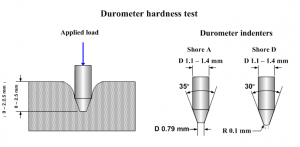The Importance of Shore A Hardness
Apr 17, 2019
 You’ll see us talk a lot about Shore A Hardness in our product descriptions, but what is it and why is it important for your design? Let’s find out.
You’ll see us talk a lot about Shore A Hardness in our product descriptions, but what is it and why is it important for your design? Let’s find out.
What is Shore A hardness?
Shore Hardness is a measure of the resistance of a material to denting. The Shore A Hardness scale is one such unit of measurement, use to determine the hardness of flexible rubbers and elastomers. The scale ranges from extremely pliable to hard with almost no flexibility at all.
In general, the higher the Shore A Hardness, the harder a material will be. As an example, a rubber band would have a Shore A Hardness of around 25, whereas the hard wheels of a skateboard would have a Shore A Hardness of around 98.
In terms of O-ring selection, a Shore A Hardness of around 75 is the ideal measurement. This means the O-ring will offer enough flexibility to do its job properly, while also being rigid enough to maintain its shape.
Is Shore A Hardness really important?
In a nutshell, yes. The hardness of a rubber material under consideration for an O-ring can make the difference between a successful installation and a disaster. Understanding Shore A Hardness measurements will ensure you end up with the right material for the job.
For example, if you were looking to seal a high pressure fluid, you may need a harder material with a higher Shore A Hardness. However, if you were looking to use an O-ring on delicate hardware, or need to minimise insertion force for whatever reason, a more flexible rubber with low Shore A Hardness may be better.
For more information on understanding Shore A Hardness and selecting the right material for your O-ring, our team are on hand to help. Get in touch and we’ll be pleased to assist.
